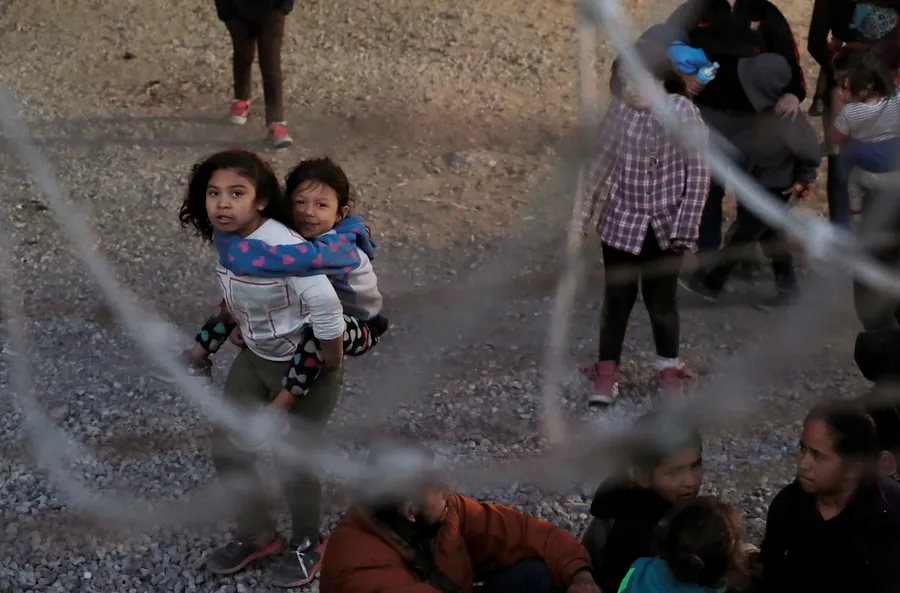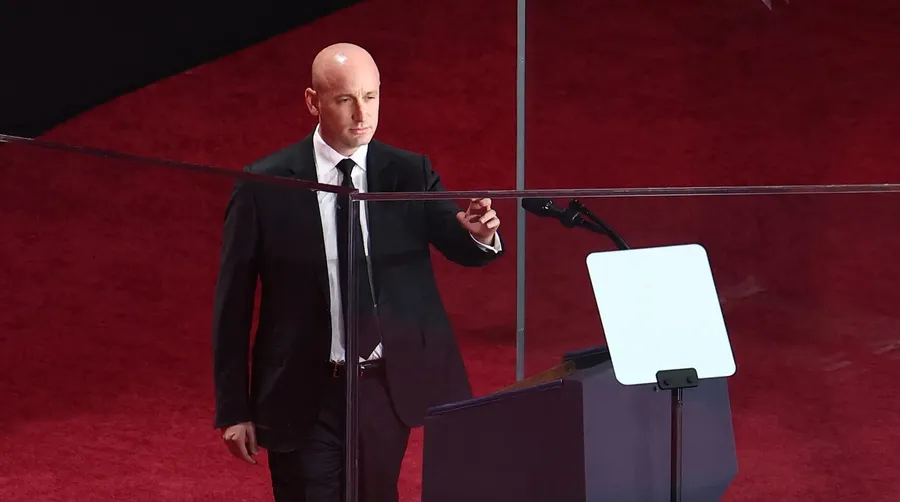Stephen Miller: The Bureaucrat of Cruelty
by Blakely B.
The Constant

Stephen Miller, center, with Jared Kushner, left, and Stephen Bannon in the Oval Office. (Evan Vucci / Associated Press)
Few figures from Donald Trump’s first administration have returned for his second. Cabinet secretaries have been replaced, advisers rotated, and the cast of political loyalists who once defined Trump’s first term has largely dispersed. Yet one name endures with unusual consistency: Stephen Miller. He remains the defining architect of Trump’s immigration agenda.
Miller’s persistence reveals something about Trump’s priorities. He prizes loyalty, but loyalty alone cannot explain Miller’s hold on power. He has become indispensable because he gives form to the instincts that define Trumpism: cruelty, isolationism, and nationalism. Miller converts these impulses into policy, translating emotion into structure.
Although never elected to political office, Miller has fundamentally shaped America’s immigration system for nearly a decade. He drafted the Muslim travel ban, orchestrated the family separation policy, engineered refugee-cap cuts, and led the attempt to terminate DACA. The question that now defines his presence is the same one that shadowed his rise: which policies, and which worldview, were so vital to Trump that he could not govern without him?
Origins of an Ideologue
Stephen Miller’s politics were forged in opposition. Raised in Santa Monica, California, he grew up in a liberal community that he came to despise. After the September 11 attacks, he began to view multiculturalism not as strength but as social decay. In high school he wrote essays accusing his classmates of “anti-Americanism” and claiming that Osama bin Laden would have felt welcome at his school. The rhetoric was adolescent, but the impulse behind it was enduring: a belief that America’s moral decline stemmed from tolerance.
At Duke University, Miller turned that impulse into vocation. He became a prolific columnist for campus and conservative outlets, attacking diversity programs and immigration policy while warning that America was losing its cultural soul. In 2007 he organized Islamo-Fascism Awareness Week, a campaign that accused universities of appeasing terrorism and portrayed Islam as inherently political and threatening [2]. The uproar it caused was precisely what Miller wanted. He learned that outrage could command attention more effectively than any argument.

Stephen Miller's “Terrorism Awareness Project" attempted running this ad in college newspapers nationwide back in 2007
After graduation, Miller joined Representative Michele Bachmann, whose populist nationalism mirrored his own. He managed her communications on immigration, sharpening the language of border enforcement into moral absolutes. But his real education began when he joined Senator Jeff Sessions of Alabama. Sessions was one of the most committed anti-immigration figures in Congress. Under his mentorship, Miller developed both ideological focus and procedural skill.
Through Sessions, Miller entered the orbit of restrictionist think tanks that gave his beliefs a framework. At NumbersUSA, he encountered the idea that data could legitimize xenophobia. The Center for Immigration Studies reinforced that lesson, producing pseudo-academic reports that claimed immigration depressed wages and strained public services. Many of those studies were later discredited, but their language of statistics and neutrality was powerful.
By the early 2010s, he was sending mass emails to congressional staff filled with links to Breitbart and VDARE articles, mixing alarmist headlines with the vocabulary of policy analysis. His style was abrasive, yet it proved effective. In 2013, as bipartisan senators worked toward comprehensive immigration reform, Miller and Sessions orchestrated the campaign that destroyed it. They flooded conservative media with talking points and rendered cooperation politically untouchable. The bill’s failure made Miller an ideological celebrity on the right and taught him a lesson that would define his career. Power, he realized, came not from passing legislation but from preventing it. To dominate the bureaucracy, one only needed to understand how to weaponize its rules.
The Bureaucratization of Xenophobia
When Donald Trump descended the escalator in 2015, Miller saw in him a perfect vehicle. He joined the campaign as a policy adviser and quickly became its voice on immigration. His 2016 Phoenix speech for Trump laid out the doctrine that would guide the administration: an end to “catch-and-release,” a policy of “zero tolerance,” and a vision of immigration enforcement as national salvation [3].
After Trump’s victory, Miller secured a senior advisory role in the White House. This positioned him near the center of power but just outside formal accountability. He would have the authority to draft orders and steer agencies while remaining shielded from congressional testimony. He began to remake immigration policy through the machinery of the executive branch. The first major test came with the refugee program.
Since the Refugee Act of 1980, each administration has set an annual refugee cap through an interagency process involving the State Department, the Department of Homeland Security, the Department of Health and Human Services, and the National Security Council. These agencies assess global crises, vetting capacity, and resettlement infrastructure before presenting their recommendation to the president. Congress is then consulted before finalizing the number of refugees to accept. The process is designed to balance humanitarian obligation with national interest.
Miller viewed that balance as weakness. In 2017 he intervened directly in the process, sidelining the Pentagon and intelligence agencies that traditionally provided input. He rewrote internal memoranda, replacing vetted data with statistics drawn from the Center for Immigration Studies, a group that argued refugees posed disproportionate security and economic risks. When a Health and Human Services study concluded that refugees contributed more to the economy than they cost, Miller ordered the conclusion removed. “The president believes refugees cost more,” he said. “The results of this study should not embarrass the president.”
The cap dropped to forty-five thousand, the lowest in the program’s history. It fell again in subsequent years to just over eleven thousand. Resettlement agencies that had operated for decades were forced to close. Generals and diplomats warned that the cuts undermined U.S. influence abroad. Breaking with decades of precedent, Miller interpreted the collapse as success.
With the refugee system subdued, Miller turned to another target: the Deferred Action for Childhood Arrivals program. Created in 2012, DACA granted renewable protections to roughly seven hundred thousand undocumented immigrants brought to the United States as children. The program was immensely popular, supported by nearly four in five Americans. Miller saw its popularity as proof that the public had grown complacent. Despite Trump’s public ambivalence, he pushed relentlessly for its repeal. In September 2017, Attorney General Jeff Sessions announced that the program would end, calling its recipients “illegal aliens.” The courts halted the decision, but Miller had achieved his deeper goal. He made clear that public sympathy offered no protection.
The Machinery of Suffering
The family separation policy exposed the full extent of Miller’s influence and his appetite for cruelty. In 2017, as part of a pilot program in El Paso, the Department of Homeland Security began prosecuting every adult who crossed the border illegally, even those traveling with children. Parents were sent to criminal custody while their children were classified as unaccompanied minors and placed under the Office of Refugee Resettlement. The result was chaos. Government systems were not designed to track family connections. Agents typed data manually into spreadsheets, often mistyping identification numbers. Internal reports warned that reunification would be impossible.

A young girl carries a child inside a U.S. Customs and Border Protection holding area in El Paso, Texas. (Lucas Jackson/Reuters)
Rather than stop the program, Miller and Justice Department lawyer Gene Hamilton expanded it. They persuaded Sessions to order full national implementation under the name “zero tolerance.” Sessions told U.S. attorneys, “We need to take away children,” and his deputy added that even infants were not exempt.
Thousands of families were separated in the following months. Photographs of children in chain-link enclosures and recordings of their cries drew global outrage [4]. The American Academy of Pediatrics called the policy “government-sanctioned child abuse.” [5] Miller and Hamilton continued to pressure Homeland Security Secretary Kirstjen Nielsen, calling her repeatedly to demand that she sign the order for expansion. Trump berated her in meetings, blaming her for rising border crossings. Under relentless pressure, she agreed.
By the time the policy was reversed in June 2018, more than 5,500 children had been taken from their parents. Hundreds remained un-reunited years later [6]. The Office of Inspector General later confirmed that no centralized database existed to track family links [7]. Medical experts documented trauma, depression, and regression among separated minors [8]. For Miller, the backlash was irrelevant. His goal was deterrence at any cost.
By 2019, his control over immigration was nigh absolute. He contacted lower-level officials directly, bypassing department heads and instructing them to conceal his involvement. Department meetings were moved into secure rooms to prevent leaks. When courts issued injunctions, Miller urged the Justice Department to appeal, confident that Trump’s judicial appointments would tilt outcomes in his favor.
The Costs
The measurable effects of Miller’s work are staggering. Refugee admissions fell by eighty-five percent between 2016 and 2020 [9]. Tens of thousands of asylum seekers were forced to wait in dangerous border towns in Mexico under the Migrant Protection Protocols. Human rights monitors documented that migrants trapped by the policy were exposed to rape, kidnapping, extortion, and assault [10]. Within the government, morale collapsed. An internal survey from 2019 found that fewer than half of Department of Homeland Security employees believed their leadership acted with integrity [11].
Behind those statistics was profound devastation. The Office of Inspector General concluded that the government lacked the means to reunite all separated families [7]. Physicians for Human Rights reported widespread symptoms of post-traumatic stress among asylum-seeking parents and children who were separated by the U.S. government [8]. The American Psychological Association described the policy as needless and cruel, warning that it would cause long-term psychological harm. [12] The moral reputation of the United States was eroded.
Miller’s success lay in his ability to institutionalize pain. He understood that if suffering could be reclassified as process, it would cease to provoke outrage. A child’s separation became a “case transfer.” A refugee’s exclusion became a “cap reduction.” The government spoke in neutral language while executing policies that inflicted enormous human cost.
The Continuity of Power
When Trump left office in 2021, Miller founded America First Legal, a litigation group designed to extend his philosophy through the courts. The organization filed lawsuits against Biden-era immigration reforms and corporate diversity programs, reframing inclusion as discrimination [13]. When Trump returned to the White House in 2025, Miller returned with him, now serving as Deputy Chief of Staff for Policy and Homeland Security Advisor.
The early months of the new administration showed how much Miller had learned. Policies that once faltered through chaos now advanced with precision. Asylum restrictions were expanded, and reports indicate the proposed 2026 refugee cap would be reduced by 94 percent [15][16]. A revised travel ban appeared, written to withstand legal scrutiny [14]. The same goals from the first term reemerged, but with greater competence and coordination.
Miller’s legacy is not one policy or speech, but his ability to transform how the world perceives American immigration policy—one where cruelty is not a flaw but a feature. He discovered that bureaucracy can turn moral decisions into procedural ones. Once suffering is expressed in the language of regulation, it becomes ordinary. Miller has shown that ideology can survive scandal if it is disciplined enough to hide in paperwork.
Trump thrives on volatility, but Miller represents continuity. He is the constant presence in an administration defined by turnover, the technician who proved that a government can make cruelty efficient. His endurance is not just a story of loyalty. It is the story of how bureaucracy itself can be weaponized against the vulnerable, and how the systems that sustain it can outlive the outrage they provoke.

(Charly Triballeau / Getty)
Authors note: Unless otherwise noted, all unsourced material in this article is drawn from Jonathan Blitzer’s Everyone Who Is Gone Is Here: The United States, Central America, and the Making of a Crisis.
Sources
- Blitzer, Jonathan. Everyone Who Is Gone Is Here: The United States, Central America, and the Making of a Crisis. New York: Penguin Press, 2024.
- CNN. “In College, Trump Aide Stephen Miller Led Controversial ‘Terrorism Awareness Project’ Warning of ‘Islamofascism.’” CNN Politics, February 15, 2017.
https://edition.cnn.com/2017/02/15/politics/kfile-stephen-miller-terrorism-awareness - Politico. “Full Text: Donald Trump Immigration Speech in Arizona.” Politico, August 31, 2016. https://www.politico.com/story/2016/08/donald-trump-immigration-address-transcript-227614
- ProPublica. “Listen to Children Who’ve Just Been Separated From Their Parents at the Border.” ProPublica, June 18, 2018.
https://www.propublica.org/article/children-separated-from-parents-border-patrol-cbp-trump-immigration-policy - American Academy of Pediatrics president: Trump’s family-separation policy is ‘child abuse’. The Hill, July 26, 2018. https://thehill.com/latino/392790-american-academy-of-pediatrics-president-trumps-family-separation-policy-is-child/
- Congressional Research Service. The Trump Administration’s ‘Zero Tolerance’ Immigration Enforcement Policy. CRS Report R45266, July 20, 2018.
https://www.congress.gov/crs-product/R45266 - U.S. Department of Homeland Security, Office of Inspector General. DHS Lacked Technology Needed to Successfully Account for Separated Migrant Families. OIG-20-06. Washington, D.C., November 2019. https://www.oig.dhs.gov/sites/default/files/assets/2019-11/OIG-20-06-Nov19.pdf
- Physicians for Human Rights. “‘You Will Never See Your Child Again’: The Persistent Psychological Effects of Family Separation.” February 2020.
https://phr.org/our-work/resources/you-will-never-see-your-child-again-the-persistent-psychological-effects-of-family-separation/ - U.S. Department of Homeland Security. Refugee Annual Flow Reports, 2016–2020.
https://ohss.dhs.gov/topics/immigration/refugees/annual-flow-report/historical - Human Rights Watch. Mexico: Abuses Against Asylum Seekers at U.S. Border. March 5, 2021.
https://www.hrw.org/news/2021/03/05/mexico-abuses-against-asylum-seekers-us-border
- U.S. Department of Homeland Security. 2019 Federal Employee Viewpoint Survey: Agency Management Report.
https://www.dhs.gov/sites/default/files/publications/dhs-2019-fevs-agency-managment-report.pdf - American Psychological Association. “Statement of APA President Regarding the Traumatic Effects of Separating Immigrant Families.” May 2018.
https://www.apa.org/news/press/releases/2018/05/separating-immigrant-families - Politico. “Stephen Miller to Launch a New Legal Group to Give Biden Fits.” Politico, March 26, 2021.
https://www.politico.com/news/2021/03/26/stephen-miller-legal-group-478167 - The White House. Restricting the Entry of Foreign Nationals to Protect the United States from Foreign Terrorists and Other National Security and Public Safety Threats. Presidential Proclamation, June 2025.
https://www.whitehouse.gov/presidential-actions/2025/06/restricting-the-entry-of-foreign-nationals-to-protect-the-united-states-from-foreign-terrorists-and-other-national-security-and-public-safety-threats/ - Reuters. “Trump Administration Planning 7,500-Person Refugee Ceiling, Sources Say.” Reuters, October 4, 2025.
https://www.reuters.com/world/us/trump-administration-planning-7500-person-refugee-ceiling-sources-say-2025-10-04/ - Federal Register. “Presidential Determination on Refugee Admissions for Fiscal Year 2025.” Federal Register, October 18, 2024.
https://www.federalregister.gov/documents/2024/10/18/2024-24321/presidential-determination-on-refugee-admissions-for-fiscal-year-2025